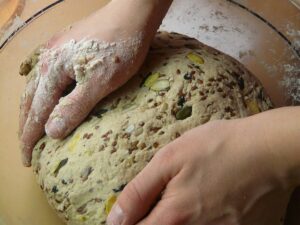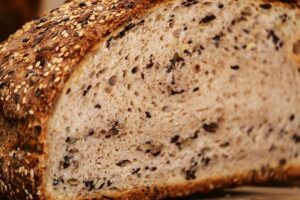Yeast is one of the most powerful ingredients in baking, though it’s often taken for granted due to its microscopic size. This single-celled fungus transforms simple ingredients into complex, flavorful, and airy baked goods through fermentation. Yeast is vital not only in bread-making but also in brewing beverages and other culinary applications. Understanding the various types of yeast, the science behind its performance, and techniques for utilizing it properly can significantly elevate your baking game. This article dives into yeast’s critical role in the baking world, exploring its history, varieties, and global uses.
Yeast Basics: The Foundation of Leavened Baking

Yeast has been used for millennia in baking and brewing. This microorganism, scientifically known as Saccharomyces cerevisiae, thrives on sugars, converting them into alcohol and carbon dioxide through fermentation. In baking, carbon dioxide gas makes dough rise, resulting in the light, fluffy texture characteristic of bread and other baked goods. But how does yeast work, and why does it matter?
The Role of Yeast in Baking Chemistry
Yeast cells consume sugars and produce two byproducts—carbon dioxide and alcohol. In a warm, moist environment, yeast ferments the available sugars, causing the dough to rise. The carbon dioxide gas becomes trapped in the dough’s gluten network, creating pockets of air that expand during baking. This expansion results in bread’s characteristic crumb structure.
Alcohol produced during fermentation evaporates during the baking process, leaving behind subtle flavors that enhance the final product’s complexity. This is why yeast-fermented dough has more depth than quick bread, which relies on baking soda or baking powder for leavening.
Why Fermentation Matters
Fermentation does much more than just help dough rise. The length of fermentation, or proofing, can drastically change the flavor and texture of the final product. Longer fermentation times allow yeast to work slowly, breaking down sugars and gluten, leading to bread with more developed, complex flavors. Sourdough, for instance, often undergoes long fermentation to develop its tangy flavor and chewy texture.
Short fermentation, on the other hand, leads to lighter and less complex flavors. Understanding how to control fermentation is a critical skill for bakers who want to fine-tune the texture and flavor of their bread.
A Brief History of Yeast: From Ancient Cultures to Modern Science
Yeast has been a trusted companion to bakers and brewers since the dawn of civilization. While modern bakers rely on commercially produced yeast, this wasn’t always the case. Early bakers accidentally captured wild yeast strains through environmental exposure.
Yeast in Ancient Civilizations
The use of yeast in baking and brewing dates back to ancient Egypt, around 4,000 BCE. Archaeological findings suggest that Egyptians were among the first to discover the leavening effects of yeast, which they used to make leavened bread. This discovery likely happened by chance, as naturally occurring wild yeast found its way into dough left in the open, causing fermentation. This leavening led to the creation of the first risen bread, a significant leap from the flatbreads consumed previously.
Other ancient cultures, such as the Babylonians and Chinese, also harnessed yeast for baking and brewing. While these early civilizations didn’t possess modern scientific knowledge, they learned to cultivate wild yeast from fruits, grains, and the air, which naturally initiated fermentation.
The Birth of Commercial Yeast
It wasn’t until the 19th century that the science behind yeast was fully understood. In 1857, French microbiologist Louis Pasteur discovered the process of fermentation, proving that yeast was responsible for converting sugars into alcohol and carbon dioxide. This discovery led to the development of commercial yeast production, allowing bakers to have a consistent and reliable source of yeast for their baking needs.
Today, yeast is cultivated in controlled environments to ensure quality consistency. Commercial yeast is available in various forms, including fresh yeast, active dry yeast, and instant yeast, all of which provide specific advantages to bakers depending on the application.
Types of Yeast: Choosing the Right Yeast for Your Baking Needs
Not all yeast is created equal. Different types of yeast are available for different purposes, and choosing the right one for your recipe can significantly impact the outcome. The three main types of yeast used in baking are fresh yeast, active dry yeast, and instant yeast.
Fresh Yeast: Professional Choice
Fresh yeast, also known as cake yeast, is moist and perishable, requiring refrigeration. It has been the traditional choice for professional bakers for years because it produces a fast rise and robust dough. Fresh yeast works particularly well with rich doughs like brioche, as these doughs benefit from its stronger fermentation.
However, fresh yeast has a short shelf life, typically lasting only about two weeks in the refrigerator. It must be dissolved in liquid before being added to the dough, and it is often sold in compressed blocks.
Active Dry Yeast: A Convenient Standby
Producers create active dry yeast by drying fresh yeast cells, placing them into a dormant state. This yeast must be rehydrated in warm water (110°F/43°C) to reactivate the cells before mixing with other ingredients.
Active dry yeast has a longer shelf life than fresh yeast and can be stored in a cool, dry place for months or even years. Its reliability makes it a go-to choice for home bakers.
Instant Yeast: Fast and Effective
Instant yeast is a more potent version of active dry yeast. It’s pre-hydrated during production, meaning it doesn’t need to be dissolved in water before use and can be mixed directly into the flour. Instant yeast works faster and more efficiently, which makes it ideal for recipes requiring short rise times.
Due to its speed, instant yeast is commonly used in bread machines and quick-rise doughs like pizza crusts and dinner rolls. It’s the most convenient type of yeast for modern bakers who want to minimize waiting time.
Techniques for Working with Yeast: Optimizing Your Baking
Understanding yeast types is only the beginning. Proper techniques are crucial for achieving the best results when working with yeast doughs. Temperature, hydration, and fermentation times all play a significant role in the performance of yeast.
Hydration: The Key to Activating Yeast
Hydration is critical for activating yeast. For fresh and active dry yeast, this means dissolving the yeast in warm water before adding it to the dough. The water should be between 100°F and 110°F (37°C to 43°C) to ensure that the yeast is activated without being killed by excessive heat. Instant yeast, however, can be added directly to dry ingredients without pre-hydration.
The right water-to-flour ratio also affects how yeast performs. A well-hydrated dough will rise better and develop a more open crumb structure. On the other hand, a dry dough will ferment more slowly and produce a denser texture.
Temperature Control: Striking the Right Balance
Yeast thrives in warm, moist environments. However, the ideal temperature range for yeast activity is between 75°F and 95°F (24°C to 35°C). Too low of a temperature will slow down fermentation, while temperatures above 130°F (54°C) will kill the yeast cells, rendering them inactive.
Professional bakers often use proofing boxes to maintain consistent temperature and humidity levels during the dough’s rise. At home, bakers can create a warm environment by placing the dough in an oven with the light on or near a warm surface.
Enhancing Flavor with Longer Fermentation
While faster rising times are convenient, longer fermentation can enhance the flavor and texture of the bread. Artisan bread often undergoes long, slow rises—sometimes up to 24 hours—allowing the yeast to break down the complex carbohydrates in flour into simpler sugars. This process creates deeper, more complex flavors in the finished bread.
Some bakers even refrigerate their dough for an extended period, a technique called retarding, which slows the fermentation process and results in a more flavorful loaf.
Global Bread Traditions: Yeast in the World’s Kitchens

Around the globe, yeast plays a critical role in different bread traditions. From French baguettes to Ethiopian injera, yeast is essential in creating the textures and flavors unique to each culture’s cuisine.
Sourdough: A Wild Yeast Tradition
Sourdough is one of the oldest and most beloved forms of yeast bread. Unlike commercial yeast, sourdough relies on wild yeast and lactic acid bacteria present in the environment. These wild yeasts create a complex and tangy flavor distinctive to sourdough.
Bakers naturally cultivate sourdough starters from flour and water, which often absorb unique characteristics from the local environment. Sourdough bread takes longer to rise than commercial yeast breads but rewards bakers with a chewy texture and a deep, slightly sour flavor.
Global Yeast-Driven Recipes
Different countries have developed unique yeast-based recipes that are now enjoyed worldwide. Italy is known for its ciabatta and focaccia, both of which use yeast for their airy, chewy textures. Germany’s pretzels rely on yeast fermentation for their soft, chewy interior and crisp crust. In the U.S., buttermilk pancake mix batter often includes yeast to create a fluffy and light texture, enhancing the classic breakfast favorite.
In India, yeast is used in flatbreads such as naan, which are quickly baked in hot tandoor ovens. Yeast also plays a significant role in steamed buns, a staple in many Asian countries, where dough is leavened with yeast and then steamed rather than baked.
The Future of Yeast in Baking: Innovation and Sustainability
The future of yeast in baking is evolving alongside scientific advancements. With more emphasis on sustainability, researchers are exploring new ways to enhance yeast performance and reduce the environmental impact of yeast production.
Genetically Modified Yeast: A New Frontier
Advances in genetic modification have led to the development of yeast strains that are more efficient and resilient. These modified yeast strains can thrive in harsher conditions, resist spoilage, and even improve the nutritional value of baked goods. While debate surrounds the use of genetically modified organisms (GMOs) in food, these developments could lead to more sustainable baking practices.
Yeast from Alternative Sources
Scientists are also exploring alternative sources of yeast beyond traditional strains. Yeast derived from mushrooms or algae offers new opportunities for baking, with potential benefits such as enhanced flavors and textures, and even a higher nutritional profile.

